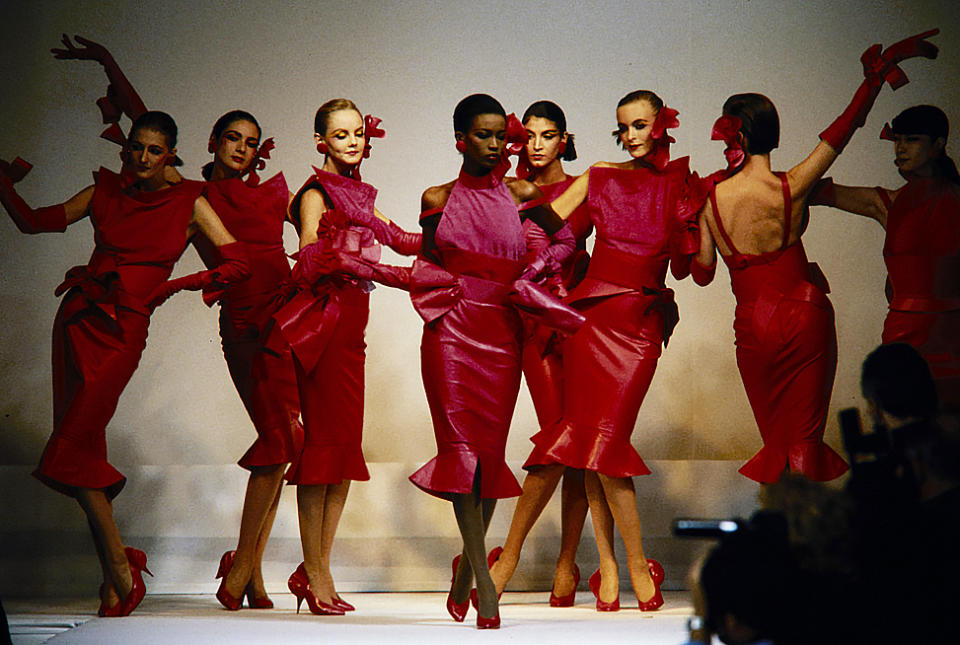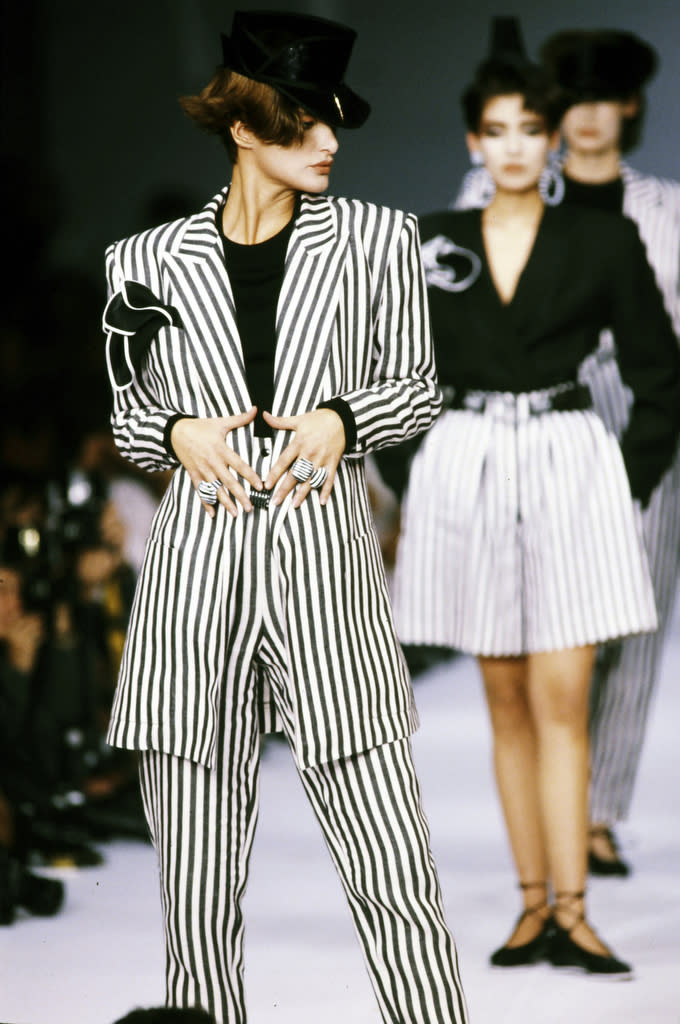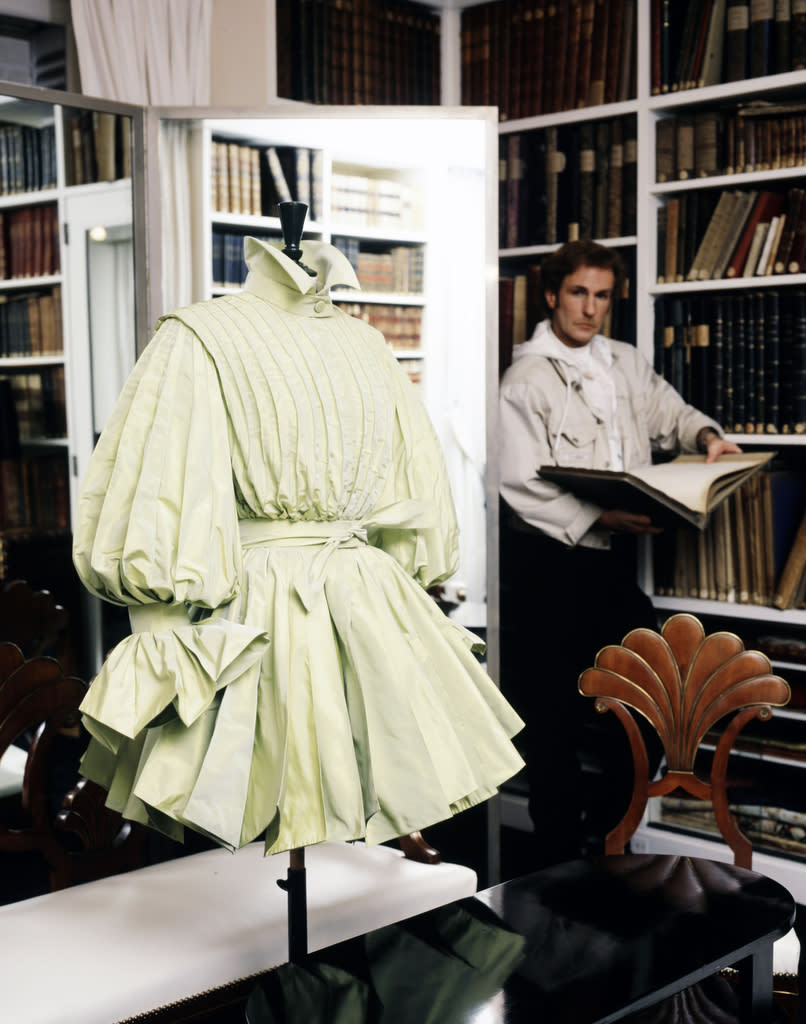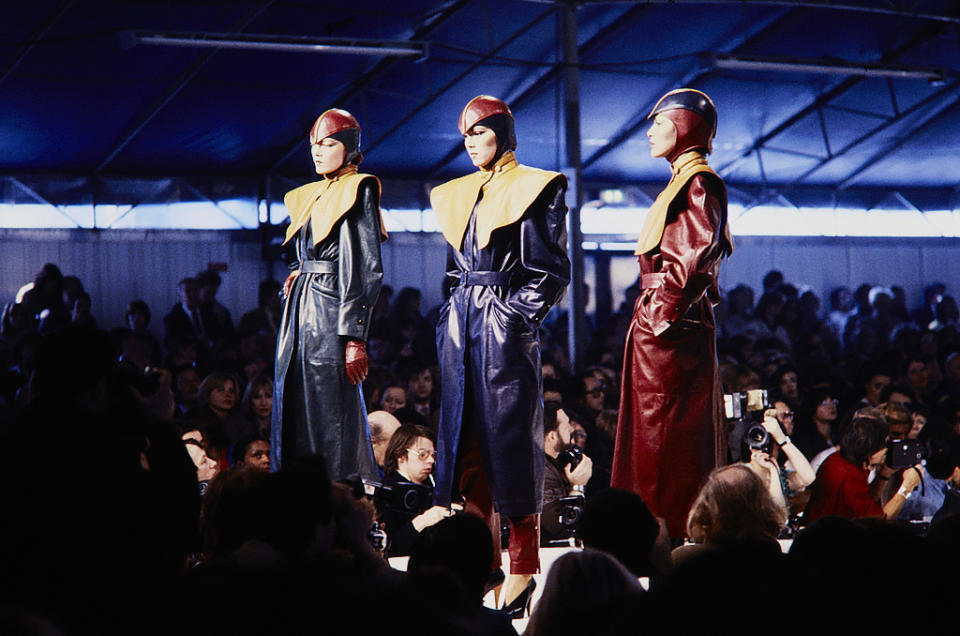Claude Montana Dead at 76
- Oops!Something went wrong.Please try again later.
- Oops!Something went wrong.Please try again later.
- Oops!Something went wrong.Please try again later.

Updated Feb. 23 4:44 p.m.
PARIS — Claude Montana, the French designer who defined power-woman dressing in the 1980s, has died in Paris at the age of 76.
More from WWD
Brooklyn Museum's American Art Reinstallation Will Center Black Feminist Perspectives
EXCLUSIVE: Y/Project Cancels Paris Fashion Week Runway Show Citing 'Uncertain Times'
Fellow designers, executives, models and former colleagues remembered him as much for his masterly cuts and fetishistic approach to curves as for the personal demons that snuffed out his career at the height of his powers.
Though he was mainly known for the exaggerated silhouettes that earned him the nickname “King of the Shoulder Pad,” Montana was celebrated for his razor-sharp tailoring and skill with leather, as well as his exquisite use of color — from chic navy and black to brilliant hues of fuchsia, emerald and his signature cobalt blue.
In his heyday, together with Thierry Mugler and Jean Paul Gaultier, he represented the provocative avant-garde of Paris fashion. Montana also designed Lanvin couture between 1990 and 1992.

Gaultier paid tribute to his talent. “Claude Montana was a fabulous designer who staged fabulous and extraordinary shows. He was peerless in his use of leather, which was the star material of his collections,” he said.
Milliner Stephen Jones remembered him as a “genius” and a perfectionist.
“I worked with him for 17 years, on women’s, men’s, licenses and Lanvin, and he was just extraordinary. He was a great friend and teacher. His discipline in cutting was unlike anyone else’s — he would cut and recut and make sure the clothes were perfect,” said Jones, who remembers seeing Linda Evangelista and Christy Turlington wait until 4 a.m. for fittings with Montana. “They waited because they knew the clothes would fit more perfectly than in any other show,” he said.
“[Montana] pushed me to be more creative, and was a very stern disciplinarian. He would say, ‘Take it apart, start again, you can do it,’” said Jones. “He had an eye for silhouette, detail, coloring and jewelry, and he was very much about incredibly glamorous — yet discreet — tailoring. He understood the drama of the silhouette. Like Thierry Mugler and Azzedine Alaïa, he looked at curves, not lines, and he was all about sculpture. And Yves Saint Laurent once said he thought Claude was the one person who could take over from him when he stopped working.”
Jones added that Montana remains an influence. “Often, when I look at the line of the brim of a hat, I say to myself: ‘What would Claude think?’”
Montana gradually faded from the scene after the house was sold twice in two years, following a turbulent period that saw it file for protection from creditors in 1997. The couturier withdrew from the public eye after staging his last Paris catwalk show in 2002, and in recent years lived as a recluse.
The Fédération de la Haute Couture et de la Mode confirmed his death, which was initially reported by French news agency AFP. He is survived by a brother but his sister Jacqueline, who had been by his side from the start, passed away last year.
“The work of Claude Montana embodied exceptional craftsmanship. His daring creations influenced a whole generation of designers. His distinctive style, blending sophistication and modernity, remains firmly rooted in the imagination of contemporary fashion, testifying to his indelible impact on the industry and on generations to come,” said Bruno Pavlovsky, president of the French fashion federation.
“A visionary, Claude Montana constantly pushed the boundaries of fashion, reaching beyond his time to redefine standards of style and design. He challenged expectations and opened up new paths for creative expression,” added Pascal Morand, the organization’s executive president.
“Montana has had an enormous impact on all designers who want to create a tough chic look. He did that practically better than anyone,” said Valerie Steele, director of The Museum at FIT.
“There were similarities with Mugler, but Mugler’s work was campier and more playful. Montana’s was more fierce and hard chic. Designers are always into that, but certainly it comes back as a trend periodically,” she added.
Montana’s broad-shouldered jackets and sexy leather jackets and trousers for men and women played into the corporate power dressing that women embraced in the ’80s, Steele said. “But his version was always much more eroticized,” she opined.
“Cut, textures and color,” is how the designer summed up his contribution to the style annals in an interview with WWD in 2010. “Fashion is in constant evolution, and what remains unchanged are the things I love profoundly: black and white, gray, navy, the basic colors — the real colors which you can then play with and build on by adding others.”
Montana — who was renowned for living life in the fast lane throughout the ’80s and early ’90s — said he lost his motivation “over time,” but offered little explanation as to why his business faltered. “We did a lot of volume in my day. But you know, I think one does not really think about all these problems. I think instinct is very important in this profession,” he offered.
Jacqueline Montana blamed his sensitive nature. “A designer is someone fragile who needs support, and I think perhaps he did not receive as much support as he needed,” she noted at the time.
Born in Paris to a German mother and a Catalan father, Montana moved to London in the early ’70s and began producing papier-mâché jewelry that soon caught the eye of British Vogue. After returning to Paris, he designed for MacDouglas Leathers before founding his own label in 1979.
At first, Montana’s aggressive silhouettes shocked American critics and buyers. He was accused of being misogynistic and promoting a “neo-Nazi” aesthetic, though his leather-and-studs looks owed more to the gay subculture than to any political movement.
By the mid-’80s, Montana’s catwalk shows — with their haughty, Amazonian models styled to perfection — had become the hottest ticket in town.
“There were a lot of looks that were lifted from men’s wardrobes,” he recalled. Montana also had a fondness for uniforms, riffing on the outfits worn by aviators, marines, factory workers and even the members of the illustrious French Academy.

Model Pat Cleveland, who worked with him from the start, described it as agony and ecstasy.
“He took a look at the darkness and was deeper than nightime. He made those Gothic, romantic costumes that were sort of devilish and forbidden. It was sort of Edgar Allan Poe,” she said. “It was wonderful to be with Montana. He was always pushing my body into shapes. He was extraordinary in how he wanted the body to be seen.”
Recalling how Montana and Mugler were like “parallel universes,” Cleveland said Montana once asked her: “‘Who do you like the most — me or Thierry?’ There were so few models that were presenting in that way at that time. The designers were using certain girls to tell a story.”
For the 1988 Bicentennial Wool Collection fashion show at the Sydney Opera House in Australia, Montana had instructed Cleveland how to walk a certain way, despite wearing a leather outfit “that was so skintight that it was like a second skin. It was black, dark, Gothic and totally binding at the kneecaps.”
She recalled that Prince Charles and Princess Diana were the guests of honor at the event. “I did my very best to have that particular kind of walk for him. I remember that Prince Charles jumped up and started applauding, when I came out on the runway in that Montana dress,” she said.
By then, the designer’s burgeoning fashion empire included women’s and men’s ready-to-wear; licenses such as scarves, ties and eyewear, and a bestselling perfume, Montana Pour Femme.
Despite his growing success, the designer was media-shy, cultivating a reputation as a tortured perfectionist. But he was eyeing the pinnacle of his profession: haute couture.
“When you are a fashion designer, you dream of one thing only, and that is couture. If you get a chance to do it, it is amazing,” he said.
Montana recounted that in the late ’80s, he was approached by Christian Dior and Givenchy to take over as creative director. But a firm offer came in 1989 from the ailing house of Lanvin, which allowed Montana to take control of its couture division without taking responsibility for rtw. Though the contract ended after just five seasons, Montana drew praise from critics, winning two consecutive Golden Thimble awards — an industry first.
His aesthetic was personified by his muse, the androgynous American model Wallis Franken, who would go on to become Montana’s wife in 1993 in a marriage of convenience that ended tragically with her death in 1996. Franken fell from a window of their apartment, in what was ruled a suicide.
Many people in the industry indirectly blamed Montana for her death, saying he contributed to her depressive state by being physically and emotionally abusive. He never spoke about it, and Franken was not featured prominently in a book about the designer published in 2010.
Carla Sozzani, founder of 10 Corso Como and Fondazione Sozzani, was a friend of the couple.
“Claude Montana has marked the history of fashion as one of the most important and influential creators of our time, from craftmanship to image he had all the possible talents. Personally we were linked by my dearest friend Wallis and our common birthdays. They will be forever in my heart,” she said.
Many considered that he had squandered his gifts. Speaking in 2004, Yves Saint Laurent said Montana was the only designer alive at the time with “talent and force,” but noted his struggles with substance abuse.
“He was the only one who had the breadth. Much more scope than even Galliano. More modern. More contemporary. But he burned his brain with narcotics and he is incapable of doing anything today. But he had real talent. A talent that was modern, young, new, provocative,” he told WWD.
“He was the greatest of them all,” agreed consultant and former Gaultier executive Donald Potard, who became acquainted with Montana in the ‘80s. “He worked like no one else, particularly with leather.”
Sadly, Montana had “an insane amount of talent but a deplorable way of life,” pushing away friends and close associates with his mercurial character, Potard continued. “He could have ruled the world but in the end he was alone and in dire financial straits.”
“It’s a huge waste,” former business and creative partner Béatrice Paul told WWD, adding that she “didn’t like the later Claude but loved [him] very much.”
They began working together after meeting as young people in the mid-‘70s, with Paul helping Montana show his very first designs to press and later teaming up to launch his eponymous brand, starting with Ferrer y Santis as a licensee.
But this “beautiful adventure” soured when Montana’s struggles with substance abuse brought their relationship to a head.
“We did extraordinary work together but he decided to break everything,” she said of her 1994 exit from the company after a two-decade partnership.

Recalling the backstage scene at Montana’s runways shows in the ‘70s and ‘80s, photographer Paul Van Riel said: “His shows were fun to photograph because he was one of the leading designers. He was one of the big names with Thierry Mugler. His shows were different from Dior or Yves Saint Laurent. It was younger, modern, now and today.”
Matthew Yokobosky, senior curator of fashion and material culture at the Brooklyn Museum, credited Montana, along with Gaultier and Mugler, for being “among the revolutionary French designers that really defined the look and broad-shouldered silhouette of the late ’70 and early ‘80s.”
While researching the Brooklyn Museum’s exhibition “Studio 54: Night Magic,” Yokobosky said the late photographer Roxanne Lowit told him about shooting her first fashion show in New York: Montana’s display at Studio 54 in September 1979.
It featured Cleveland and other models, and many of the “in” people of the time turned up, including Stephen Burrows, Victor Hugo, Grace Jones, Larry and Valerie LeGaspi, André Leon Talley and Egon von Furstenberg.
Describing the film of Montana’s Studio 54 show, which was featured in the exhibition, Yokobosky said: “He created such beautiful lines, and was a true master of materials, including leather.”
The designer’s leather dresses appealed to many, including the heiress Doris Duke. Referencing an Interview magazine review of Montana’s second collection, which was heavy on leather looks, he said the show’s soundtrack had been the sound of barking dogs. Yokobosky also praised Montana’s work at Lanvin, “which really deserves an exhibition — one day I hope!”
Although his creations for Lanvin in the early ‘90s were “glamorous and gorgeous in pearlescent colors, women couldn’t really get into them, because many were trousers and jackets. They were seen as too androgynous,” according to Steele.
Claude Montana Dead at 76: Photos Through the Years



The Museum at FIT does not have enough pieces from Montana for an exhibition. Steele wishes that she did. Noting that his Lanvin designs are “extremely difficult to find,” she said: “He is definitely a designer whose work I would like to acquire more of.”
Montana briefly reappeared in the public eye in 2013, when he designed three looks for Éric Tibusch’s fall collection. “It was difficult to plunge back into this whole story,” he said. “I absolutely wanted to come back, but it perhaps did not happen in the ideal conditions that we could have imagined.”
Perhaps surprisingly for a designer of his stature, Montana has never been the subject of a museum retrospective, but he refused to dwell on the reasons why.
“Listen, that’s the way it happened. You must not ask yourself too many questions,” he says. “I am nostalgic for a period, for the powerful moments I lived. But bitter — no.”

— With contributions from Samantha Conti, Luisa Zargani, Lily Templeton and Rosemary Feitelberg
Launch Gallery: Claude Montana Dead at 76: Photos Through the Years
Best of WWD

